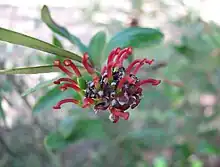Grevillea evansiana
Grevillea evansiana, commonly known as Evans grevillea,[2] is a species of flowering plant in the family Proteaceae and is endemic to a restricted area of New South Wales. It is a low, dense, spreading shrub with elliptic leaves and usually blackish-red flowers with a burgundy-coloured style.
| Grevillea evansiana | |
|---|---|
 | |
| In Maranoa Gardens | |
| Scientific classification | |
| Kingdom: | Plantae |
| Clade: | Tracheophytes |
| Clade: | Angiosperms |
| Clade: | Eudicots |
| Order: | Proteales |
| Family: | Proteaceae |
| Genus: | Grevillea |
| Species: | G. evansiana |
| Binomial name | |
| Grevillea evansiana | |
| Synonyms[1] | |
Description
Grevillea evansiana is a low, dense, spreading shrub that typically grows to a height of up to 50 cm (20 in), rarely to 1.5 m (4 ft 11 in) and has branchlets covered with white, woolly hairs. Its leaves are usually elliptic, 25–60 mm (0.98–2.36 in) long and 3–10 mm (0.12–0.39 in) wide, the lower surface sillky-hairy. The flowers are arranged in more or less spherical clusters, usually on a peduncle 5–15 mm (0.20–0.59 in) long, on the ends of branchlets. The flowers are usually blackish-red with a burgundy style, rarely white with a greenish-cream style, the pistil 9–10 mm (0.35–0.39 in) long and the style strongly curved. Flowering occurs from August to December and the fruit is a glabrous, oblong follicle 10–12 mm (0.39–0.47 in) long.[2][3][4]
Taxonomy
Grevillea evansiana was first formally described in 1953 by Hugh Shaw MacKee in Proceedings of the Linnean Society of New South Wales from specimens he collected near the Cudgegong River in the Rylstone area in 1951.[5][6] The specific epithet (evansiana) honours Obed David Evans.[6]
Distribution and habitat
Evans grevillea usually grows in forest or woodland, sometimes in swampy heath and is only known from east of Rylstone in New South Wales.[2][3]
Conservation status
Grevillea evansiana is listed as "vulnerable" under the Australian Government Environment Protection and Biodiversity Conservation Act 1999 and the New South Wales Biodiversity Conservation Act 2016. The main threat to its survival is habitat disturbance and degradation due to recreational activities.[2][4][7]
References
- "Grevillea evansiana". Australian Plant Census. Retrieved 16 April 2022.
- Makinson, Robert O. "Grevillea evansiana". Royal Botanic Garden Sydney. Retrieved 17 April 2022.
- Makinson, Robert O. "Grevillea evansiana". Australian Biological Resources Study, Department of Agriculture, Water and the Environment. Retrieved 20 February 2022.
- "Evans Grevillea - profile". New South Wales Government Office of Environment and Heritage. Retrieved 17 April 2022.
- "Grevillea evansiana". APNI. Retrieved 17 April 2022.
- MacKee, Hugh S. (1953). "An Undescribed Species Of Grevillea from the Rylstone District". Proceedings of the Linnean Society of New South Wales. 78 (3–4): 49–50. Retrieved 17 April 2022.
- "Approved Conservation Advice for Grevillea evansiana (Evans Grevillea)" (PDF). Australian Government Department of Agriculture, Water and the Environment. Retrieved 17 April 2022.
